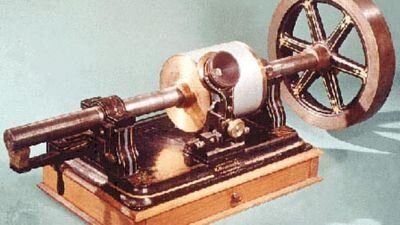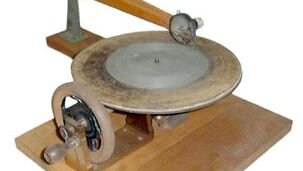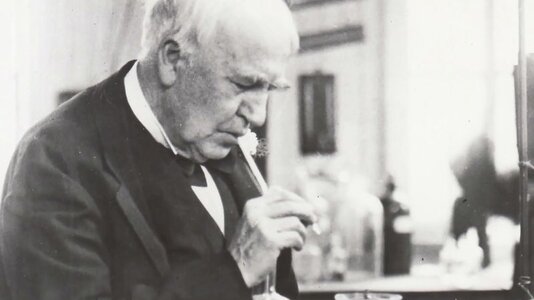- Messages
- 1,102
On another note. Why not take a few minutes and learn something instead of banging your head listening to Snowfall today.
American inventor Thomas Edison patented the phonograph
phonograph, instrument for reproducing sounds by means of the vibration of a stylus, or needle, following a groove on a rotating disc. A phonograph disc, or record, stores a replica of sound waves as a series of undulations in a sinuous groove inscribed on its rotating surface by the stylus. When the record is played back, another stylus responds to the undulations, and its motions are then reconverted into sound.

1 of 2
Thomas Edison's phonograph of 1877Thomas Edison's phonograph of 1877.By transcribing sound vibrations as a series of tiny pits on the tinfoil surface of a revolving cylinder, this became the first device to play back recorded sound.

2 of 2
gramophoneEmile Berliner's gramophone of 1888.By recording sound as an undulating side-to-side groove on a flat disc, Berliner's invention established the basic design for the next 100 years of phonographic record players.
Though experimental mechanisms of this type appeared as early as 1857, the invention of the phonograph is generally credited to the American inventor Thomas Edison (1877). His first recordings were indentations embossed into a sheet of tinfoil by a vibrating stylus; the tinfoil was wrapped around a cylinder that was rotated as the sounds were being recorded. Improvements in Edison’s process followed, notable among which were Emil Berliner’s innovation in 1887 of tracing sound grooves in a spiral on a flat disc rather than in a helix on a cylinder. A negative was made from the flat master disc, and the negative then used as a mold for making many copies that reproduced the original master disc. These “records,” as they came to be known, could be played on a reproducing machine Berliner named a Gramophone.

The role of chemistry in Thomas Edison's inventionsHow Thomas Edison changed the world.
See all videos for this article
Improved methods of molding disc records followed in the early 20th century, and by 1915 the 78-RPM (revolutions-per-minute) record, with a playing time of about 4 1/2 minutes per side, had become standard. In the early 1920s electric loudspeakers were adopted to amplify the volume of reproduced sound. In 1948 Columbia Records introduced the long-playing (LP) record, which, with a rotational speed of 331/3 RPM and the use of very fine grooves, could yield up to 30 minutes of playing time per side. Shortly afterward RCA Corporation introduced the 45-RPM disc, which could play for up to 8 minutes per side. These LP’s and “singles” supplanted 78s in the 1950s, and stereophonic (or “stereo”) systems, with two separate channels of information in a single groove, became a commercial reality in 1958. Stereo phonographs capable of the undistorted reproduction of sound became one component of what is known as a high-fidelity sound system.
American inventor Thomas Edison patented the phonograph
phonograph, instrument for reproducing sounds by means of the vibration of a stylus, or needle, following a groove on a rotating disc. A phonograph disc, or record, stores a replica of sound waves as a series of undulations in a sinuous groove inscribed on its rotating surface by the stylus. When the record is played back, another stylus responds to the undulations, and its motions are then reconverted into sound.

1 of 2
Thomas Edison's phonograph of 1877Thomas Edison's phonograph of 1877.By transcribing sound vibrations as a series of tiny pits on the tinfoil surface of a revolving cylinder, this became the first device to play back recorded sound.

2 of 2
gramophoneEmile Berliner's gramophone of 1888.By recording sound as an undulating side-to-side groove on a flat disc, Berliner's invention established the basic design for the next 100 years of phonographic record players.
Though experimental mechanisms of this type appeared as early as 1857, the invention of the phonograph is generally credited to the American inventor Thomas Edison (1877). His first recordings were indentations embossed into a sheet of tinfoil by a vibrating stylus; the tinfoil was wrapped around a cylinder that was rotated as the sounds were being recorded. Improvements in Edison’s process followed, notable among which were Emil Berliner’s innovation in 1887 of tracing sound grooves in a spiral on a flat disc rather than in a helix on a cylinder. A negative was made from the flat master disc, and the negative then used as a mold for making many copies that reproduced the original master disc. These “records,” as they came to be known, could be played on a reproducing machine Berliner named a Gramophone.

The role of chemistry in Thomas Edison's inventionsHow Thomas Edison changed the world.
See all videos for this article
Improved methods of molding disc records followed in the early 20th century, and by 1915 the 78-RPM (revolutions-per-minute) record, with a playing time of about 4 1/2 minutes per side, had become standard. In the early 1920s electric loudspeakers were adopted to amplify the volume of reproduced sound. In 1948 Columbia Records introduced the long-playing (LP) record, which, with a rotational speed of 331/3 RPM and the use of very fine grooves, could yield up to 30 minutes of playing time per side. Shortly afterward RCA Corporation introduced the 45-RPM disc, which could play for up to 8 minutes per side. These LP’s and “singles” supplanted 78s in the 1950s, and stereophonic (or “stereo”) systems, with two separate channels of information in a single groove, became a commercial reality in 1958. Stereo phonographs capable of the undistorted reproduction of sound became one component of what is known as a high-fidelity sound system.
Last edited:
